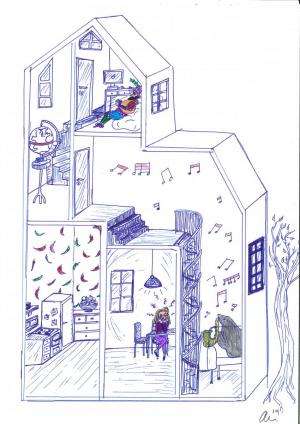Research findings shed light on brain's storage capacity and how memories are kept separate

Researchers have long wondered if there is an upper limit to our capacity to store memories and how we manage to remember so many events without mixing up events that are very similar.
To explore this issue, researchers at the Norwegian University of Science and Technology's (NTNU) Kavli Institute for Systems Neuroscience and Centre for Neural Computation and colleagues from the Czech Republic and Italy tested the ability of rats to remember a number of distinct but similar locations. Their findings are published in the 8 December edition of the Proceedings of the National Academy of Sciences.
The brain creates and stores memories in small networks of brain cells, with the memories of events and places stored in a structure called the hippocampus.
The researchers tested memory in seven laboratory rats by letting them run around in 11 distinct yet similar rooms over the course of two days. The freely running rats wandered around the rooms in pursuit of chocolate crumbs while researchers recorded brain activity in CA3 place cells in the hippocampus. As their name suggests, place cells are neurons that fire in a specific place.
The rooms were very alike, but the rats still managed to create a separate, independent memory, or a map for every environment, the researchers found.
The CA3 place cells the researchers recorded in the hippocampus continued to form unique representations for each environment.
The researchers also found that these unique representations or firing patterns were stored in the rats' memories so that when the animal was introduced to one of the rooms a second time, the spatial map from the rat's first exposure to the room was reactivated.
"We investigated whether these memories overlapped across some rooms, but all of the memories were completely independent," said the paper's first author, Charlotte Alme. "This indicates that the brain has an enormous capacity for storage. The ability to create a unique memory or map for every locale explains how we manage to distinguish between very similar memories and how the brain prevents us from mixing up events."
Alme says their findings also help explain why a specific memory trick called "the method of loci" works. This technique involves making a connection between things that you want to remember and places that you know quite well. By associating individual memories with different rooms in your house, for example, you can more easily recall what you need to remember by mentally walking through your house and visiting each room.
"Our paper shows that rats (and most likely humans) have a map for each individual place, which is why the method of loci works," she said. "Each place (or room in your house) is represented by a unique map or memory, and because we have so many different maps we can remember many similar places without mixing them up."
NTNU Professor and 2014 Nobel Laureate May-Britt Moser, who is the corresponding author of the paper, mentioned the research in her Nobel Lecture on 7 December in Stockholm and said that the findings were important for understanding episodic memory, or memories that are formed from autobiographical experiences.
The publication is a contribution by Professor Moser to a special series of Inaugural Articles being published by the journal in honor of those elected to the academy in 2014. Professor Moser and her husband, colleague and fellow Nobel Laureate Edvard Moser, were both elected as Foreign Associates of the US National Academy of Sciences in April.
More information: Place cells in the hippocampus: Eleven maps for eleven rooms, PNAS, www.pnas.org/cgi/doi/10.1073/pnas.1421056111


















